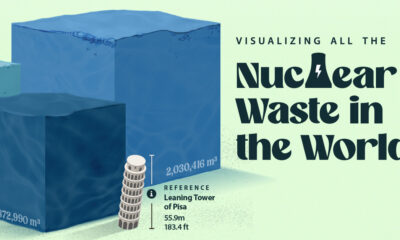Energy Shift
Forecasting U.S. Clean Energy Job Creation by State (2019-2050)
How to Use: Click the arrows on the left/right to navigate between 2030 and 2050 job projections.
The Growth of Clean Energy Jobs by State
As the world is slowly moving towards a carbon-free future, job prospects within the renewable energy industry will see a boom in the coming years. Ranging from environmental scientists to renewable energy generation technicians and engineers, clean energy jobs are growing.
Between the shuttering of coal plants and companies making efforts to use renewable sources of energy, the United States on its own could see the creation of 5 million net new jobs within the energy-supply sector, driven by clean energy.
These jobs offer a more sustainable and high-paying alternative for the current and new workforce, especially in some of the country’s highly fossil-fuel-dependent states.
Based on analysis presented by Princeton University, the above infographic visualizes the forecasted change in energy-supply jobs in every state from 2019 to 2030 and up until 2050, in a net-zero scenario.
Shift in Energy Supply Jobs by 2030: Texas on the Forefront
Between 2020 and 2021, jobs in the oil and gas sector saw a 9% decline in Texas, a reduction of more than 55,000 in the state. Despite this, Texas is still one of the largest oil and natural gas producers, employing the highest number of people.
A rapid rise in employment in the clean energy industry will compensate for this decline in fossil fuel sector jobs. Texas fossil fuel unions have also signed onto the climate action plan and vowed to create more jobs in the clean energy sector.
In the process, Texas will see nearly 135,000 net new energy-supply jobs by 2030, more than any other state.
Here’s a look at the number of forecasted net new energy-supply jobs in the rest of the country:
| State | Forecasted Net Change in Energy-supply Jobs (2019-2030) |
|---|---|
| Texas | 134,446 |
| California | 73,259 |
| Florida | 65,754 |
| South Carolina | 55,058 |
| Iowa | 46,295 |
| Virginia | 43,250 |
| New Mexico | 39,548 |
| Indiana | 38,908 |
| Missouri | 33,786 |
| Oklahoma | 30,953 |
| Nebraska | 30,866 |
| Illinois | 30,003 |
| New York | 26,063 |
| North Carolina | 25,789 |
| Kansas | 22,064 |
| Colorado | 18,634 |
| Washington | 17,272 |
| Alabama | 12,977 |
| New Jersey | 12,845 |
| Minnesota | 12,726 |
| Michigan | 12,546 |
| Georgia | 12,375 |
| Oregon | 11,794 |
| Pennsylvania | 11,581 |
| Massachusetts | 11,332 |
| North Dakota | 10,319 |
| Mississippi | 9,564 |
| Louisiana | 7,460 |
| Utah | 7,388 |
| Idaho | 6,758 |
| Maryland | 6,461 |
| Connecticut | 6,429 |
| Nevada | 6,358 |
| Montana | 6,014 |
| Ohio | 5,873 |
| Kentucky | 5,106 |
| Maine | 4,483 |
| Arizona | 3,962 |
| South Dakota | 3,904 |
| Tennessee | 3,752 |
| Wyoming | 2,458 |
| New Hampshire | 2,167 |
| Arkansas | 1,991 |
| Vermont | 1,591 |
| Delaware | 1,538 |
| Rhode Island | 1,399 |
| Wisconsin | 863 |
| West Virginia | -1521 |
| Total U.S. | 852,651 |
Note: Negative values indicate a decline in energy-supply jobs by 2030.
Shift in Energy Supply Jobs by 2050: Wisconsin Advances
Wisconsin has stated its desire to transition to 100% clean energy by 2050, growing the state’s economy by more than $21 billion.
According to Princeton, Wisconsin could also introduce more than 46,000 net new energy-supply jobs by 2050, a tremendous leap over the state’s 863 new jobs forecasted through 2030.
| State | Forecasted Net Change in Energy-supply Jobs (2019-2050) |
|---|---|
| Texas | 728,899 |
| California | 356,350 |
| Iowa | 266,464 |
| Florida | 262,254 |
| Nebraska | 216,561 |
| Oklahoma | 213,432 |
| Virginia | 209,840 |
| Colorado | 183,014 |
| Indiana | 170,705 |
| Illinois | 165,348 |
| Minnesota | 154,014 |
| Oregon | 139,981 |
| Kansas | 135,561 |
| Georgia | 130,015 |
| Pennsylvania | 127,286 |
| Missouri | 126,825 |
| Alabama | 125,812 |
| New York | 121,786 |
| Washington | 107,267 |
| Maine | 102,026 |
| Mississippi | 92,425 |
| North Dakota | 86,490 |
| Michigan | 80,755 |
| New Mexico | 76,566 |
| Tennessee | 74,275 |
| North Carolina | 74,150 |
| South Carolina | 62,779 |
| Wyoming | 61,225 |
| Montana | 60,127 |
| Ohio | 53,848 |
| Wisconsin | 46,445 |
| New Hampshire | 44,025 |
| South Dakota | 43,916 |
| Arkansas | 42,038 |
| Maryland | 39,527 |
| West Virginia | 32,439 |
| Nevada | 30,990 |
| Kentucky | 29,243 |
| Idaho | 28,371 |
| Utah | 28,059 |
| Vermont | 26,293 |
| Arizona | 14,399 |
| Delaware | 11,954 |
| New Jersey | 11,091 |
| Louisiana | 9,969 |
| Connecticut | 5,644 |
| Rhode Island | 1,478 |
| Massachusetts | -6,703 |
| Total U.S. | 5,160,124 |
Note: Negative values indicate a decline in energy-supply jobs by 2050.
The state of Wyoming has the second-highest change in energy supply jobs, going from 2,400 jobs by 2030 to nearly 62,000 by 2050. Meanwhile, California, Florida, and Texas will continue their commitment to being leaders and introducing more clean energy-supply jobs by 2050.
The only states that will see a decline in clean energy jobs between their 2030 and 2050 totals are the northeastern states of Connecticut, New Jersey, and Massachusetts.
Most states have taken measures to create more sustainable and high-paying jobs without leaving the current workforce in the lurch. On average, U.S. states will see an increase of 105,000 energy-supply jobs by 2050.
As the states and the country make this transition and federal and private investment in the renewable energy industry increases, it’ll be interesting to keep track of how new clean energy jobs impact the economy.
Energy Shift
The World’s Biggest Oil Producers in 2023
Just three countries accounted for 40% of global oil production last year.

The World’s Biggest Oil Producers in 2023
This was originally posted on our Voronoi app. Download the app for free on iOS or Android and discover incredible data-driven charts from a variety of trusted sources.
Despite efforts to decarbonize the global economy, oil still remains one of the world’s most important resources. It’s also produced by a fairly limited group of countries, which can be a source of economic and political leverage.
This graphic illustrates global crude oil production in 2023, measured in million barrels per day, sourced from the U.S. Energy Information Administration (EIA).
Three Countries Account for 40% of Global Oil Production
In 2023, the United States, Russia, and Saudi Arabia collectively contributed 32.7 million barrels per day to global oil production.
| Oil Production 2023 | Million barrels per day |
|---|---|
| 🇺🇸 U.S. | 12.9 |
| 🇷🇺 Russia | 10.1 |
| 🇸🇦 Saudi Arabia | 9.7 |
| 🇨🇦 Canada | 4.6 |
| 🇮🇶 Iraq | 4.3 |
| 🇨🇳 China | 4.2 |
| 🇮🇷 Iran | 3.6 |
| 🇧🇷 Brazil | 3.4 |
| 🇦🇪 UAE | 3.4 |
| 🇰🇼 Kuwait | 2.7 |
| 🌍 Other | 22.8 |
These three nations have consistently dominated oil production since 1971. The leading position, however, has alternated among them over the past five decades.
In contrast, the combined production of the next three largest producers—Canada, Iraq, and China—reached 13.1 million barrels per day in 2023, just surpassing the production of the United States alone.
In the near term, no country is likely to surpass the record production achieved by the U.S. in 2023, as no other producer has ever reached a daily capacity of 13.0 million barrels. Recently, Saudi Arabia’s state-owned Saudi Aramco scrapped plans to increase production capacity to 13.0 million barrels per day by 2027.
In 2024, analysts forecast that the U.S. will maintain its position as the top oil producer. In fact, according to Macquarie Group, U.S. oil production is expected to achieve a record pace of about 14 million barrels per day by the end of the year.
Energy Shift
How Much Does the U.S. Depend on Russian Uranium?
Despite a new uranium ban being discussed in Congress, the U.S. is still heavily dependent on Russian uranium.

How Much Does the U.S. Depend on Russian Uranium?
This was originally posted on our Voronoi app. Download the app for free on iOS or Android and discover incredible data-driven charts from a variety of trusted sources.
The U.S. House of Representatives recently passed a ban on imports of Russian uranium. The bill must pass the Senate before becoming law.
In this graphic, we visualize how much the U.S. relies on Russian uranium, based on data from the United States Energy Information Administration (EIA).
U.S. Suppliers of Enriched Uranium
After Russia invaded Ukraine, the U.S. imposed sanctions on Russian-produced oil and gas—yet Russian-enriched uranium is still being imported.
Currently, Russia is the largest foreign supplier of nuclear power fuel to the United States. In 2022, Russia supplied almost a quarter of the enriched uranium used to fuel America’s fleet of more than 90 commercial reactors.
| Country of enrichment service | SWU* | % |
|---|---|---|
| 🇺🇸 United States | 3,876 | 27.34% |
| 🇷🇺 Russia | 3,409 | 24.04% |
| 🇩🇪 Germany | 1,763 | 12.40% |
| 🇬🇧 United Kingdom | 1,593 | 11.23% |
| 🇳🇱 Netherlands | 1,303 | 9.20% |
| Other | 2,232 | 15.79% |
| Total | 14,176 | 100% |
SWU stands for “Separative Work Unit” in the uranium industry. It is a measure of the amount of work required to separate isotopes of uranium during the enrichment process. Source: U.S. Energy Information Administration
Most of the remaining uranium is imported from European countries, while another portion is produced by a British-Dutch-German consortium operating in the United States called Urenco.
Similarly, nearly a dozen countries around the world depend on Russia for more than half of their enriched uranium—and many of them are NATO-allied members and allies of Ukraine.
In 2023 alone, the U.S. nuclear industry paid over $800 million to Russia’s state-owned nuclear energy corporation, Rosatom, and its fuel subsidiaries.
It is important to note that 19% of electricity in the U.S. is powered by nuclear plants.
The dependency on Russian fuels dates back to the 1990s when the United States turned away from its own enrichment capabilities in favor of using down-blended stocks of Soviet-era weapons-grade uranium.
As part of the new uranium-ban bill, the Biden administration plans to allocate $2.2 billion for the expansion of uranium enrichment facilities in the United States.
-

 Electrification3 years ago
Electrification3 years agoRanked: The Top 10 EV Battery Manufacturers
-

 Electrification2 years ago
Electrification2 years agoThe Key Minerals in an EV Battery
-

 Real Assets3 years ago
Real Assets3 years agoThe World’s Top 10 Gold Mining Companies
-

 Misc3 years ago
Misc3 years agoAll the Metals We Mined in One Visualization
-

 Electrification3 years ago
Electrification3 years agoThe Biggest Mining Companies in the World in 2021
-

 Energy Shift2 years ago
Energy Shift2 years agoWhat Are the Five Major Types of Renewable Energy?
-

 Electrification2 years ago
Electrification2 years agoMapped: Solar Power by Country in 2021
-

 Electrification2 years ago
Electrification2 years agoThe World’s Largest Nickel Mining Companies





















